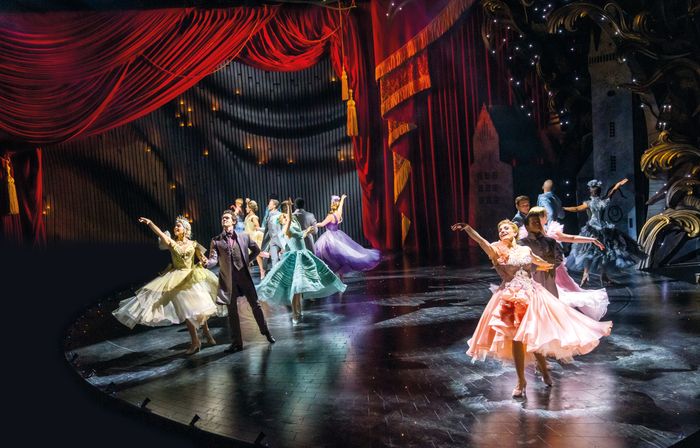Cinderella is the latest musical written by legendary producer, Andrew Lloyd Webber and the first new production to open in the West-End since COVID-19 restrictions lifted. To mark the occasion, Olivier Award winning sound designer, Gareth Owen, was called upon to provide a d&b Soundscape solution.
Cinderella isn’t Owen’s first collaboration with Andrew Lloyd Webber, so he was confident Soundscape would deliver both technically and creatively. “He and I have worked together on a number of shows; the renewed version of Starlight Express was the first. His core belief about how music should sound is replicated in what Soundscape does – sound has to emanate from its source.”
By applying Soundscape’s object positioning software, En-Scene, sound objects can be located around the room, ensuring a natural sound image that connects the eyes and the ears. By utilising multiple loudspeakers, in either a 180° or 360° setup, the listener’s visual and audio experience is in harmony, free from sensory distraction and the physical presence of a traditional line array setup. The results are so compelling that the audiences are often unaware that amplification has been used at all. For Owen, this is “the Holy Grail,” in terms of measuring the success of a design.
It’s this ability to use sound to tell stories – without distractions – that’s given Soundscape special status for Owen, as part of a product portfolio he already knows and trusts. “Soundscape makes the audience forget about the sound system without compromising sound quality. It enables the audience to enjoy every last detail of the show. It’s a double-edged sword, but as sound designers we know we have got it right when nobody talks about the sound – but rather about their experience on an emotional level.”
A unique challenge for the team on this unconventional show was providing full, ambient orchestral sound despite the usual pit location being unavailable. With a stage extension covering the traditional pit area, the musicians are relocated to the left hand side of the stage, on a double story tower structure hidden from the audience’s view. Localisation of the instruments therefore did not make sense; instead Owen wanted to “enhance that sweeping, orchestral sound you expect from a live show.”
By applying Soundscape’s room emulation software, En-Space, and utilising a 360 degree Soundscape setup, reverberation was added to the acoustically treated theatre, to give the show that concert hall feeling, in which the audience is enveloped in a grandiose atmosphere of powerful, emotive music.
The revolving auditorium posed the next significant challenge for the production team. When turning, the auditorium takes not only the cast and the audience with it, but also the front fills anchored in the stage. Moving loudspeakers effectively changes the sound design mid show, so Owen had to come up with a plan of creating secondary sound scenarios to keep objects localised, ensuring a seamless experience for the audience, regardless of where they, or the cast, are moved to.
“When part of the audience moves and finds themselves behind the stage, looking out onto the rest of the remaining audience, some of the sound system moves with them,” explained Owen. “We created function groups that then switch the use of those speakers; the stage foldback essentially switches with some of the surround speakers.”
For Owen and his team, solving the problem of a dynamic stage and changing loudspeaker positions was a case of pushing the boat out. The result is something unseen before. “A world first,” says Owen, “in terms of combining a rotating auditorium with object based mixing.”
Lee Batty, Technical Director at Webber’s The Really Useful Group is astounded by what was achieved. “Having the sound follow the actors around the theatre while dealing with a rotating audience space is frankly a crazy ask, and Gareth and his team have risen to the challenge with aplomb. They pulled it off perfectly.”
The team designed three different loudspeaker setups in ArrayCalc, reassigning the displaced loudspeakers’ new roles in each layout. An intricate web of perfectly timed signal chains was needed to bring this sound design to life. Three d&b DS100 Signal Matrixes have been deployed to handle the large number of signals and cross points. To maintain an overview of this complex system design, and its moving parts, Owen relied on the integration of En-Snap, a new piece of Soundscape software released in partnership with the sound designer last year.
With En-Snap users are able to apply cues to control sequences within the Soundscape setup, making the live show workflow for Soundscape even easier. Users can now program production-specific transition times and recall safe functions in every cue, freeing up time from individually tracking sound objects to actually mixing the show.
The entire system is provided by d&b partner Stage Sound Services, who specialise in theatre sound. Phil Hurley is delighted to see this show open, and with it something new for the audience. “It’s a happy distraction in these uncertain times,” as he put it. “It is great to be out there working again, especially on a show as demanding and challenging as Cinderella. Job well done to everyone.”
For Owen the outcome is a major success. “Due to the pandemic the premier was delayed, but it did give us more time to think. We managed to come up with an unseen before concept that really works. It’s phenomenal and exceeded all my expectations.”
A sentiment shared by Andrew Lloyd Webber himself, with Batty stating, “As most theatre professionals know, Andrew Lloyd Webber is extremely demanding when it comes to the sound of his shows – it’s safe to say that he is extremely happy with the sound of Cinderella.”


